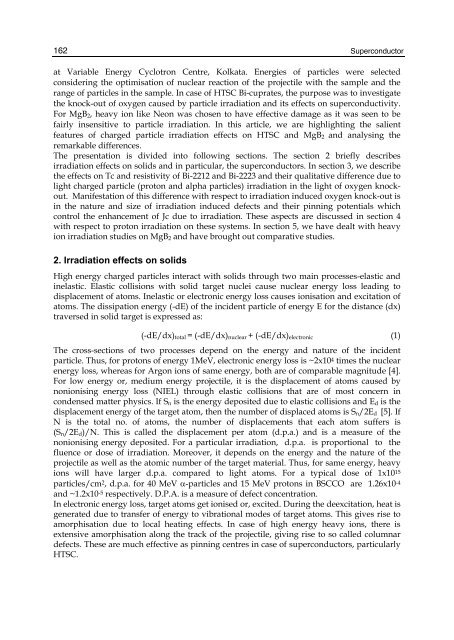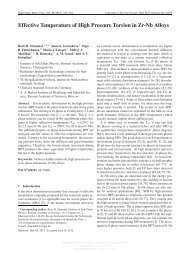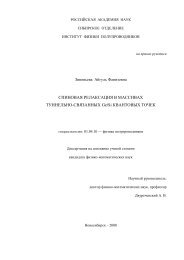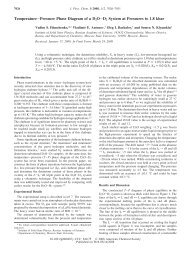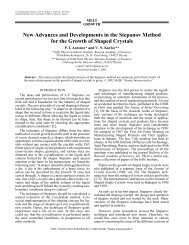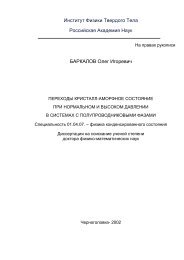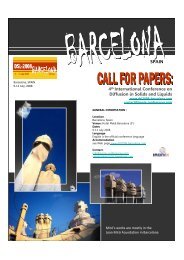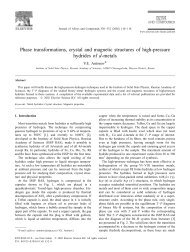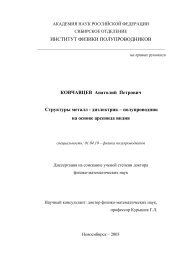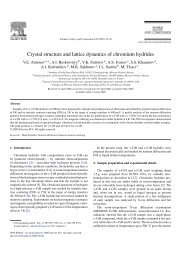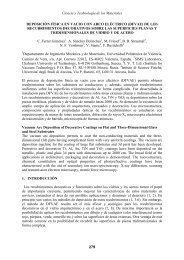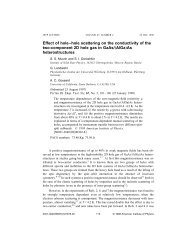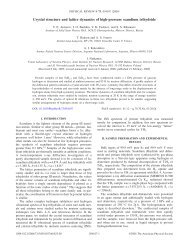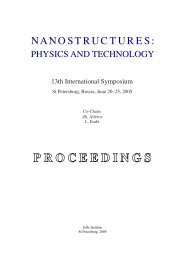Superconductor
Superconductor
Superconductor
You also want an ePaper? Increase the reach of your titles
YUMPU automatically turns print PDFs into web optimized ePapers that Google loves.
162<br />
<strong>Superconductor</strong><br />
at Variable Energy Cyclotron Centre, Kolkata. Energies of particles were selected<br />
considering the optimisation of nuclear reaction of the projectile with the sample and the<br />
range of particles in the sample. In case of HTSC Bi-cuprates, the purpose was to investigate<br />
the knock-out of oxygen caused by particle irradiation and its effects on superconductivity.<br />
For MgB2, heavy ion like Neon was chosen to have effective damage as it was seen to be<br />
fairly insensitive to particle irradiation. In this article, we are highlighting the salient<br />
features of charged particle irradiation effects on HTSC and MgB2 and analysing the<br />
remarkable differences.<br />
The presentation is divided into following sections. The section 2 briefly describes<br />
irradiation effects on solids and in particular, the superconductors. In section 3, we describe<br />
the effects on Tc and resistivity of Bi-2212 and Bi-2223 and their qualitative difference due to<br />
light charged particle (proton and alpha particles) irradiation in the light of oxygen knockout.<br />
Manifestation of this difference with respect to irradiation induced oxygen knock-out is<br />
in the nature and size of irradiation induced defects and their pinning potentials which<br />
control the enhancement of Jc due to irradiation. These aspects are discussed in section 4<br />
with respect to proton irradiation on these systems. In section 5, we have dealt with heavy<br />
ion irradiation studies on MgB2 and have brought out comparative studies.<br />
2. Irradiation effects on solids<br />
High energy charged particles interact with solids through two main processes-elastic and<br />
inelastic. Elastic collisions with solid target nuclei cause nuclear energy loss leading to<br />
displacement of atoms. Inelastic or electronic energy loss causes ionisation and excitation of<br />
atoms. The dissipation energy (-dE) of the incident particle of energy E for the distance (dx)<br />
traversed in solid target is expressed as:<br />
(-dE/dx)total = (-dE/dx)nuclear + (-dE/dx)electronic (1)<br />
The cross-sections of two processes depend on the energy and nature of the incident<br />
particle. Thus, for protons of energy 1MeV, electronic energy loss is ~2x10 4 times the nuclear<br />
energy loss, whereas for Argon ions of same energy, both are of comparable magnitude [4].<br />
For low energy or, medium energy projectile, it is the displacement of atoms caused by<br />
nonionising energy loss (NIEL) through elastic collisions that are of most concern in<br />
condensed matter physics. If Sn is the energy deposited due to elastic collisions and Ed is the<br />
displacement energy of the target atom, then the number of displaced atoms is Sn/2Ed [5]. If<br />
N is the total no. of atoms, the number of displacements that each atom suffers is<br />
(Sn/2Ed)/N. This is called the displacement per atom (d.p.a.) and is a measure of the<br />
nonionising energy deposited. For a particular irradiation, d.p.a. is proportional to the<br />
fluence or dose of irradiation. Moreover, it depends on the energy and the nature of the<br />
projectile as well as the atomic number of the target material. Thus, for same energy, heavy<br />
ions will have larger d.p.a. compared to light atoms. For a typical dose of 1x10 15<br />
particles/cm 2, d.p.a. for 40 MeV α-particles and 15 MeV protons in BSCCO are 1.26x10 -4<br />
and ~1.2x10 -5 respectively. D.P.A. is a measure of defect concentration.<br />
In electronic energy loss, target atoms get ionised or, excited. During the deexcitation, heat is<br />
generated due to transfer of energy to vibrational modes of target atoms. This gives rise to<br />
amorphisation due to local heating effects. In case of high energy heavy ions, there is<br />
extensive amorphisation along the track of the projectile, giving rise to so called columnar<br />
defects. These are much effective as pinning centres in case of superconductors, particularly<br />
HTSC.


